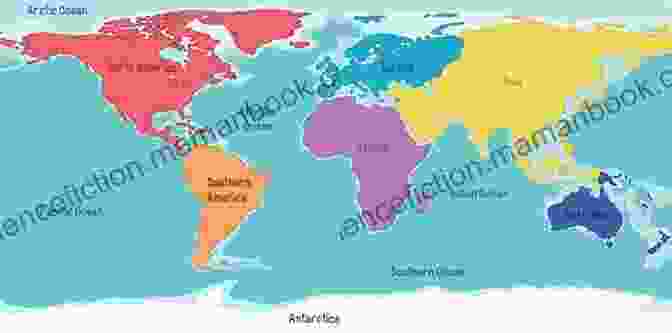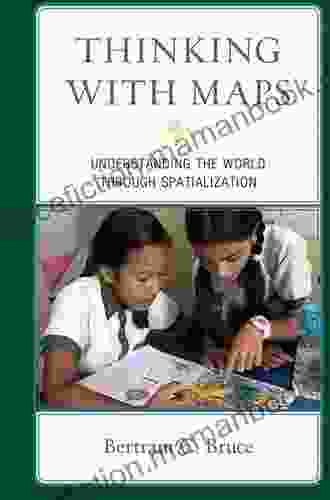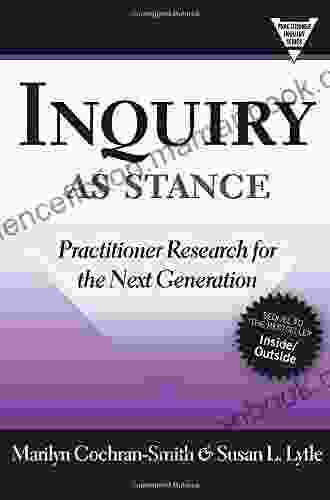Thinking With Maps: Understanding the World Through Spatialization


Maps are powerful tools that can help us understand the world around us. They can show us where things are, how they are connected, and how they have changed over time. Maps can be used for navigation, planning, and decision-making. They can also be used to tell stories and to explore new ideas.
4.6 out of 5
| Language | : | English |
| File size | : | 4509 KB |
| Text-to-Speech | : | Enabled |
| Screen Reader | : | Supported |
| Enhanced typesetting | : | Enabled |
| Word Wise | : | Enabled |
| Print length | : | 203 pages |
The process of thinking with maps is called spatialization. Spatialization is the process of representing spatial information in a way that makes it easier to understand. This can be done through the use of maps, charts, graphs, and other visual representations.
Spatialization can help us to understand the world around us in a number of ways. First, it can help us to see the relationships between different places. For example, a map of the world can show us how the continents are connected to each other and how the oceans separate them. Second, spatialization can help us to understand how things have changed over time. For example, a series of maps of the United States can show us how the country has expanded over time.
Third, spatialization can help us to make decisions. For example, a map of a city can help us to decide where to live or work. Fourth, spatialization can help us to tell stories. For example, a map of a battle can help us to understand how the battle unfolded.
There are many different types of maps, each with its own purpose. Some of the most common types of maps include:
- Reference maps: These maps show the location of physical features, such as mountains, rivers, and cities.
- Thematic maps: These maps show the distribution of a particular phenomenon, such as population density or economic activity.
- Topographic maps: These maps show the elevation of the land surface.
- Navigation maps: These maps are designed to help people find their way around.
Maps can be created using a variety of methods. Some maps are created by hand, while others are created using computer software. The method used to create a map depends on the purpose of the map and the available resources.
Maps are an essential tool for understanding the world around us. They can help us to see the relationships between different places, understand how things have changed over time, make decisions, and tell stories. By learning how to think with maps, we can gain a deeper understanding of the world around us.
## How to Think With Maps
Thinking with maps is a skill that can be learned and improved with practice. Here are a few tips for thinking with maps:
- Start by understanding the purpose of the map. What is the map trying to show you?
- Identify the key features of the map. What are the most important things that the map is showing you?
- Look for patterns and relationships. How are different features of the map connected to each other?
- Draw s. What can you learn from the map about the world around you?
By following these tips, you can learn to think with maps and gain a deeper understanding of the world around you.
##
Maps are powerful tools that can help us to understand the world around us. By learning how to think with maps, we can gain a deeper understanding of the relationships between different places, understand how things have changed over time, make decisions, and tell stories.
4.6 out of 5
| Language | : | English |
| File size | : | 4509 KB |
| Text-to-Speech | : | Enabled |
| Screen Reader | : | Supported |
| Enhanced typesetting | : | Enabled |
| Word Wise | : | Enabled |
| Print length | : | 203 pages |
Do you want to contribute by writing guest posts on this blog?
Please contact us and send us a resume of previous articles that you have written.
 Top Book
Top Book Novel
Novel Fiction
Fiction Nonfiction
Nonfiction Literature
Literature Paperback
Paperback Hardcover
Hardcover E-book
E-book Audiobook
Audiobook Bestseller
Bestseller Classic
Classic Mystery
Mystery Thriller
Thriller Romance
Romance Fantasy
Fantasy Science Fiction
Science Fiction Biography
Biography Memoir
Memoir Autobiography
Autobiography Poetry
Poetry Drama
Drama Historical Fiction
Historical Fiction Self-help
Self-help Young Adult
Young Adult Childrens Books
Childrens Books Graphic Novel
Graphic Novel Anthology
Anthology Series
Series Encyclopedia
Encyclopedia Reference
Reference Guidebook
Guidebook Textbook
Textbook Workbook
Workbook Journal
Journal Diary
Diary Manuscript
Manuscript Folio
Folio Pulp Fiction
Pulp Fiction Short Stories
Short Stories Fairy Tales
Fairy Tales Fables
Fables Mythology
Mythology Philosophy
Philosophy Religion
Religion Spirituality
Spirituality Essays
Essays Critique
Critique Commentary
Commentary Glossary
Glossary Bibliography
Bibliography Index
Index Table of Contents
Table of Contents Preface
Preface Introduction
Introduction Foreword
Foreword Afterword
Afterword Appendices
Appendices Annotations
Annotations Footnotes
Footnotes Epilogue
Epilogue Prologue
Prologue Felipe Alvarez
Felipe Alvarez Rosie Thomas
Rosie Thomas David Burke
David Burke William A Owings
William A Owings Patrick C Harrison Iii
Patrick C Harrison Iii Sam J Fires
Sam J Fires Jennifer Monroe
Jennifer Monroe Angie Hockman
Angie Hockman Stuart E Lucas
Stuart E Lucas Ramona Ausubel
Ramona Ausubel Tibor Fischer
Tibor Fischer Cj Lyons
Cj Lyons Kai Strand
Kai Strand Benjamin Levin
Benjamin Levin Paula Mclain
Paula Mclain Florence Peterson
Florence Peterson Burton Raffel
Burton Raffel Paul Hoover
Paul Hoover Princess Bola Adelani
Princess Bola Adelani Soweto Satir
Soweto Satir
Light bulbAdvertise smarter! Our strategic ad space ensures maximum exposure. Reserve your spot today!

 Frank MitchellKnitting Pattern Kp168: A Comprehensive Guide to Creating an Enchanting Baby...
Frank MitchellKnitting Pattern Kp168: A Comprehensive Guide to Creating an Enchanting Baby...
 E.M. ForsterAll You Need to Know About Sanitation, Hygiene, and Operations, Inclusive of...
E.M. ForsterAll You Need to Know About Sanitation, Hygiene, and Operations, Inclusive of... Damon HayesFollow ·13k
Damon HayesFollow ·13k Donald WardFollow ·14.3k
Donald WardFollow ·14.3k Edwin CoxFollow ·6.3k
Edwin CoxFollow ·6.3k Alfred RossFollow ·9k
Alfred RossFollow ·9k Danny SimmonsFollow ·14.1k
Danny SimmonsFollow ·14.1k Zachary CoxFollow ·5.7k
Zachary CoxFollow ·5.7k Pat MitchellFollow ·19.9k
Pat MitchellFollow ·19.9k Michael ChabonFollow ·5.8k
Michael ChabonFollow ·5.8k

 Ashton Reed
Ashton ReedClean(ish) Food for People Who Like to Eat Dirty
By: [Your Name] Are...

 Ronald Simmons
Ronald SimmonsThe Handbook for Educators: A Comprehensive Guide to...
The Handbook for...

 Derrick Hughes
Derrick HughesAny Place Hang My Hat: A Hauntingly Beautiful Novel by...
A Masterpiece of...

 Adrien Blair
Adrien BlairFly Me to the Moon Vol. 5: A Lunar Odyssey through...
In the vast...

 William Powell
William PowellTips By Gardeners On Variety Of Subjects
Gardening...
4.6 out of 5
| Language | : | English |
| File size | : | 4509 KB |
| Text-to-Speech | : | Enabled |
| Screen Reader | : | Supported |
| Enhanced typesetting | : | Enabled |
| Word Wise | : | Enabled |
| Print length | : | 203 pages |










